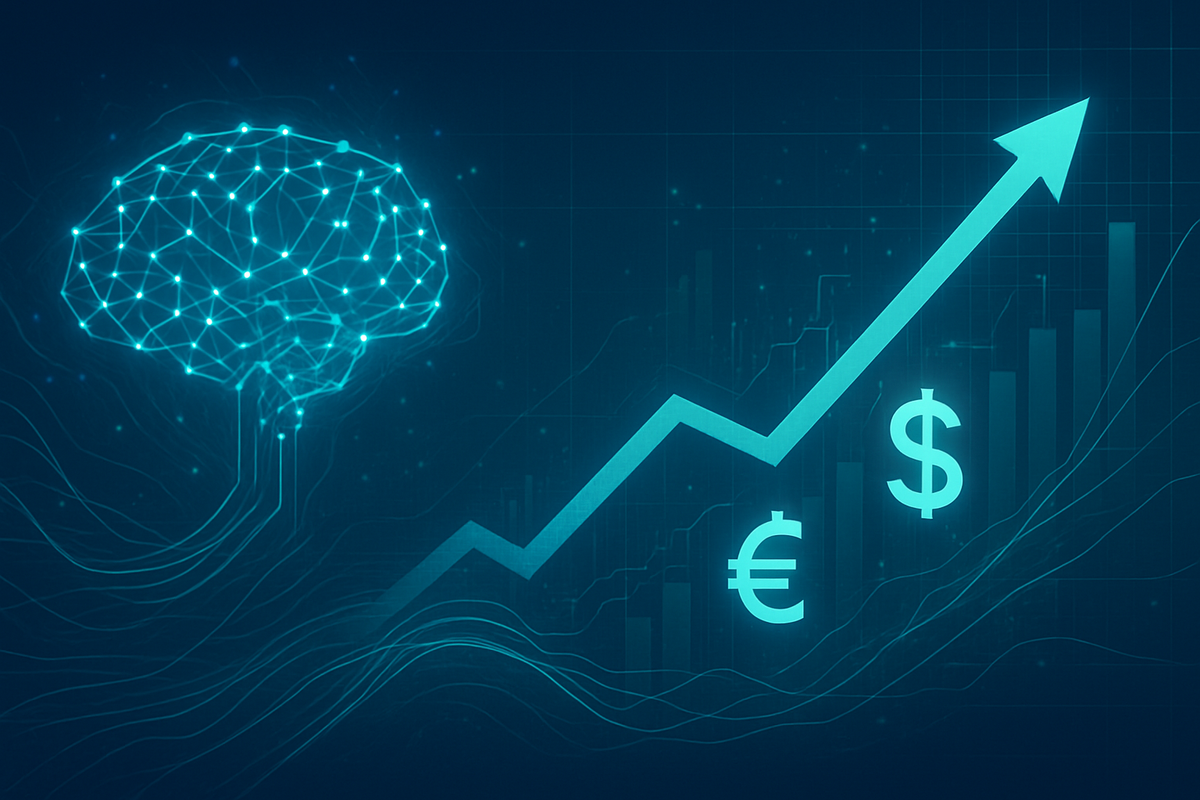
As of November 20, 2025, the US financial markets are in the throes of a transformative period, largely dictated by the relentless surge of artificial intelligence. The AI boom, while acting as a formidable engine for economic growth and market expansion, simultaneously casts a long shadow of uncertainty, prompting a shift in investor sentiment from unbridled enthusiasm to a more measured prudence. This technological revolution is not merely reshaping industry landscapes but is fundamentally altering the trajectory of tech stocks and serving as a potent catalyst for mergers and acquisitions (M&A) activities, as companies scramble to acquire crucial AI capabilities.
The immediate implications are profound. Tech stocks, particularly those deeply embedded in the AI ecosystem, have been the primary beneficiaries, driving the US stock market to unprecedented highs. However, this meteoric rise has ignited fervent debates about the potential for an "AI bubble," reminiscent of the dot-com era. Concurrently, M&A volumes have surged, reflecting a strategic imperative for businesses to integrate AI into their core operations, transforming not only the targets of acquisitions but also the very processes of deal-making itself.
The AI Revolution: A Detailed Look at Market Transformation
The year 2025 has cemented artificial intelligence as an undeniable force in both the US economy and its financial markets. This technological ascendancy has been a key factor propelling the US stock market to record valuations, providing a significant buffer against various economic headwinds. AI-related capital expenditures alone are estimated to have contributed a substantial 1.1% to US GDP growth in the first half of 2025. The initial fervor surrounding the development of large language models (LLMs) has matured into a strategic focus on integrating AI into existing workflows, with investors increasingly favoring startups that demonstrate practical enterprise adoption and tangible revenue generation.
However, this rapid expansion has not been without its anxieties. A palpable concern about an "AI bubble" has permeated market discourse throughout the year. A Bank of America Global Research survey in October 2025 underscored this apprehension, revealing that 45% of global fund managers identified an AI bubble as the foremost market risk. This sentiment is fueled by immense spending on AI infrastructure and, in some instances, a significant disparity between investment and revenue. For example, while OpenAI reportedly secured deals amounting to $1.5 trillion, its projected revenue for 2025 stands at a comparatively modest $20 billion. The AI boom's focus is also expanding to encompass the physical infrastructure necessary to support it, including energy, cooling systems, networking, and semiconductors, prompting active analysis from the Federal Reserve on its broader economic and financial implications.
The tech sector has experienced a period of remarkable volatility and a noticeable sell-off in November 2025, primarily due to growing apprehension over potentially inflated valuations within the AI sphere. The tech-heavy Nasdaq Composite has seen declines, and several AI-linked stocks have entered "correction" territory, signifying a fall of over 10% from their recent peaks. Notably, Nvidia (NASDAQ: NVDA), the leading AI chipmaker, which briefly touched a market capitalization of $5 trillion in October 2025, experienced an almost 11% loss in the month leading up to its November 18, 2025, earnings release. Despite strong earnings reports and optimistic outlooks from key players like Nvidia providing temporary relief, investors are increasingly prioritizing demonstrable profitability and sustainable business models over speculative growth, sparking a contentious debate among analysts regarding whether this represents a "healthy correction" or the initial stages of a bubble burst.
The AI boom has also acted as a profound strategic catalyst for M&A activities, fundamentally reshaping the rationale and execution of deals. Global M&A volumes in 2025 reached $4.3 trillion, marking a significant 39% increase from the previous year. This surge is predominantly driven by mega-deals across the technology, healthcare, and financial services sectors, reflecting a strategic pivot towards calculated intent rather than mere speed. AI-driven transformation is now a key global dealmaking trend, with companies increasingly engaging in M&A to swiftly acquire AI technologies, expertise, and talent. This includes a resurgence of "acqui-hires," where startups are acquired primarily for their skilled workforce, with nearly two-thirds (64%) of business leaders surveyed in January 2025 indicating plans to use M&A to bolster their AI capabilities within the subsequent 12 months.
Navigating the AI Landscape: Winners and Losers
The AI boom has created a clear delineation between potential winners and those facing significant disruption. At the forefront of the beneficiaries are companies that provide the foundational infrastructure for AI, particularly semiconductor manufacturers like Nvidia (NASDAQ: NVDA), whose specialized chips are indispensable for AI training and deployment. Their continued innovation and market dominance place them in a strong position to capitalize on the sustained demand for AI hardware. Other "Magnificent 7" companies, including Alphabet (NASDAQ: GOOGL), Amazon (NASDAQ: AMZN), Apple (NASDAQ: AAPL), Meta (NASDAQ: META), Microsoft (NASDAQ: MSFT), and Tesla (NASDAQ: TSLA), are also poised to win, given their substantial investments in AI research, development, and integration across their vast ecosystems. Microsoft, for instance, has strategically integrated AI into its cloud services and productivity suites, enhancing its competitive edge.
Software companies that successfully embed AI into their existing products and services are also strong contenders. Enterprises that leverage AI to significantly improve efficiency, personalize customer experiences, or develop entirely new revenue streams stand to gain market share and profitability. This includes companies across various sectors, from financial services utilizing AI for algorithmic trading and fraud detection to healthcare companies employing AI for drug discovery and diagnostics. The M&A landscape reflects this, with companies actively acquiring AI startups to gain a competitive advantage, leading to higher valuations for innovative AI-focused firms.
Conversely, companies that fail to adapt to the AI paradigm risk being left behind. Traditional businesses with outdated infrastructure or a reluctance to invest in AI integration could face declining competitiveness and market relevance. Industries heavily reliant on manual processes or repetitive tasks are particularly vulnerable to AI-driven automation, potentially leading to job displacement and reduced demand for their services. Furthermore, smaller tech companies that cannot compete with the R&D budgets and market reach of the "Magnificent 7" or other well-funded AI players may struggle to survive or may become acquisition targets at less favorable valuations. The rapid pace of AI development also means that companies that invest in the wrong AI technologies or strategies could incur significant losses, highlighting the importance of agile and informed decision-making.
The M&A market, while booming, also presents risks for acquirers. Overpaying for AI startups with unproven revenue models or failing to effectively integrate acquired AI technologies and talent can lead to financial setbacks. The increasing complexity of due diligence in AI-related deals, encompassing intellectual property, data privacy, and ethical AI considerations, adds another layer of challenge. Companies that do not adequately assess these risks or struggle with post-merger integration may find their strategic AI acquisitions turning into costly liabilities.
Wider Significance: Reshaping Industries and Regulatory Horizons
The AI boom in US financial markets is not an isolated event but a powerful current within broader industry trends, accelerating the digital transformation across nearly every sector. It signifies a profound shift towards data-driven decision-making, automation, and hyper-personalization, pushing companies to redefine their operational models and competitive strategies. This event fits into the larger narrative of technological disruption, where innovation rapidly renders old business models obsolete and creates entirely new markets. The emphasis on practical enterprise adoption of AI, rather than just foundational model development, signals a maturation of the technology and its deeper integration into the fabric of the economy.
The ripple effects of this AI surge are pervasive, impacting competitors and partners alike. Companies that embrace AI early and effectively gain a significant competitive advantage, forcing their rivals to accelerate their own AI initiatives or risk losing market share. This creates a dynamic where even established industry leaders must constantly innovate and adapt. For partners, AI presents opportunities for collaboration in developing integrated solutions or challenges in adapting their offerings to an AI-centric ecosystem. For instance, cloud providers are seeing increased demand for AI-specific infrastructure, while traditional software vendors are rushing to infuse AI into their products. The increasing focus on physical infrastructure for AI, such as energy and cooling systems, also creates new growth areas and strategic partnerships for related industries.
Regulatory and policy implications are rapidly emerging as a critical aspect of the AI boom. Governments and financial authorities, including the Federal Reserve, are grappling with how to effectively govern AI to ensure financial stability, prevent market manipulation, protect data privacy, and address ethical concerns. Discussions around data governance, algorithmic bias, and the potential for systemic risks introduced by highly interconnected AI systems are gaining traction. The need for specialized counsel and tailored deal structuring in M&A transactions involving AI highlights the evolving legal landscape. Historically, similar periods of rapid technological advancement, such as the internet boom, eventually led to new regulatory frameworks. The current AI boom is likely to follow a similar trajectory, with potential regulations impacting everything from data usage to the transparency of AI models.
Comparing the current AI boom to historical precedents, such as the dot-com bubble of the late 1990s, offers both cautionary tales and valuable insights. While the rapid rise in tech valuations and the "AI bubble" concerns echo the past, the fundamental difference lies in the tangible economic impact and broad applicability of AI across diverse industries. Unlike some speculative internet ventures, AI is demonstrating real-world productivity gains and driving significant capital expenditures. However, the risk of overvaluation and the eventual correction remains a key lesson from history, emphasizing the importance of sustainable business models and demonstrable profitability over speculative growth.
What Comes Next: Navigating the Future of AI in Finance
Looking ahead, the short-term possibilities for the AI boom in US financial markets involve continued volatility, particularly within the tech sector, as investors refine their understanding of sustainable AI growth versus speculative valuations. We can expect further corrections in specific AI-linked stocks that lack clear profitability pathways, while companies demonstrating tangible revenue generation from AI integration will likely see continued investment. M&A activities will remain robust, with a heightened focus on strategic acquisitions that fill specific AI capability gaps or secure critical talent. The debate surrounding an "AI bubble" will persist, influencing market sentiment and investor behavior in the coming months.
In the long term, AI is poised to fundamentally reshape the financial industry, driving increased automation, more sophisticated risk management, and personalized financial products. Strategic pivots will be essential for financial institutions, requiring significant investments in AI infrastructure, talent development, and robust data governance frameworks. Companies that can effectively integrate AI across their operations, from front-office customer interactions to back-office processing, will gain a significant competitive advantage. This will also necessitate adaptations in regulatory approaches, with a likely evolution of frameworks to address the unique challenges and opportunities presented by advanced AI.
New market opportunities will emerge in several areas. The demand for specialized AI infrastructure, including advanced data centers, energy solutions, and high-performance networking, will continue to grow, creating opportunities for companies in these sectors. The development of ethical AI solutions, auditing tools, and AI governance platforms will also become increasingly vital, fostering a new niche market. Furthermore, AI will unlock new possibilities in personalized finance, algorithmic trading, and predictive analytics, creating avenues for innovative fintech companies. Challenges will include managing the ethical implications of AI, addressing job displacement concerns, and ensuring data security and privacy in an increasingly AI-driven world.
Potential scenarios and outcomes range from a "healthy correction" that rebalances valuations and reinforces sustainable growth, to a more pronounced "AI winter" if speculative investments lead to widespread disillusionment. A more optimistic scenario involves AI continuing its trajectory as a foundational technology, driving sustained productivity gains and fostering a new era of innovation across all sectors, with financial markets adapting and integrating AI as a core component of their operations. The most likely outcome is a nuanced path, characterized by periods of both rapid growth and consolidation, with AI evolving into a mature and indispensable technology, albeit with ongoing debates about its societal and economic impact.
Comprehensive Wrap-up: A Market in Flux
The AI boom represents a pivotal moment for US financial markets, characterized by both unprecedented opportunities and significant risks. Key takeaways from this period of rapid transformation include the undeniable economic impact of AI, driving GDP growth and market valuations, coupled with persistent concerns about an "AI bubble." The shift in investor sentiment towards prioritizing demonstrable profitability from AI integration, rather than purely speculative growth, marks a crucial maturation of the market. Furthermore, the strategic imperative of AI in M&A activities highlights its role as a core driver of corporate strategy and competitiveness.
Moving forward, the market will continue to be shaped by the interplay of technological advancement, investor sentiment, and evolving regulatory landscapes. The "Magnificent 7" and other AI infrastructure providers will remain central to the narrative, but the focus will increasingly shift to how effectively AI is integrated across broader industries. The ability of companies to translate AI investments into tangible revenue and sustainable business models will be the ultimate determinant of long-term success.
The lasting impact of the AI boom will likely be a more efficient, data-driven, and automated financial system, alongside significant shifts in labor markets and industry structures. AI is not merely a transient trend but a foundational technology that will redefine how businesses operate and how value is created. Investors should closely watch for regulatory developments, the emergence of new AI applications with clear revenue streams, and the ability of companies to demonstrate responsible and ethical AI deployment. The coming months will be crucial in determining whether the current market dynamics represent a healthy recalibration or the precursor to a more significant market correction, all within the context of AI's undeniable and ever-growing influence.
This content is intended for informational purposes only and is not financial advice







